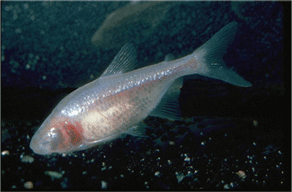Can Mexican Cave Fish Tell the Time?
Abstract
An international team of scientists, using equipment supplied by RS Hydro, conduct an experiment to discover if fish in a Mexican cave have a 'biological clock' that effects their daily behaviour and physiology.
Equipment Used
Multi-parameter water quality sonde
Background
 The majority of plants and animals on the planet, including humans, contain a biological clock that controls when they are active, as well as their internal physiology. There has always been thought to be two exceptions to this fact: animals that live in deep-sea environments and those that live in caves. The reasons for this are quite obvious in that both of these environments are thought to be constant, with no day-night changes.
The majority of plants and animals on the planet, including humans, contain a biological clock that controls when they are active, as well as their internal physiology. There has always been thought to be two exceptions to this fact: animals that live in deep-sea environments and those that live in caves. The reasons for this are quite obvious in that both of these environments are thought to be constant, with no day-night changes.
It is our aim to see if this is really true, or whether animals in caves do know the time of day. We have initially focused on a species of Mexican cavefish, which have evolved in the caves of North East Mexico. These animals have lost their eyes, and their bodies have become very pale as adaptations to life in underground pools. From work in the lab and in the field, we know that these animals still possess the genes necessary for a functional clock. But do they use it in the cave, and if so how is their clock set correctly in the dark?
 Our team, made up of scientists from the UK, France, Japan, Mexico and the USA, are exploring gene function under natural conditions, and looking to see if this blind fish knows when the 'morning comes'. As part of this effort we are also performing precise measurements of the environmental conditions in several Mexican caves, including the exact condition of the water in these supposedly constant
underground pools. For this we are using a multi-parameter water quality sonde from RS Hydro, to monitor and log daily changes in water quality.
Our team, made up of scientists from the UK, France, Japan, Mexico and the USA, are exploring gene function under natural conditions, and looking to see if this blind fish knows when the 'morning comes'. As part of this effort we are also performing precise measurements of the environmental conditions in several Mexican caves, including the exact condition of the water in these supposedly constant
underground pools. For this we are using a multi-parameter water quality sonde from RS Hydro, to monitor and log daily changes in water quality.
The multi-parameter sonde can measure level, temperature, dissolved oxygen, turbidity, conductivity, pH/ORP, nitrate, chloride and ammonia using plug in sensors. The sonde has an onboard data logger and batteries and can be left in-situ for up to 12 months without any additional power. By following animal behaviour with infrared cameras, monitoring gene function in living animals, and continuously monitoring the aquatic environment, we hope to find out if these animals can still measure time in a cave.


